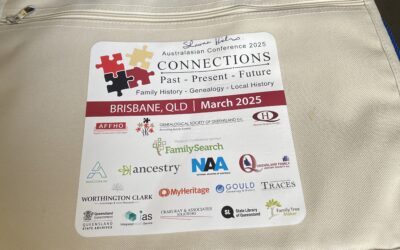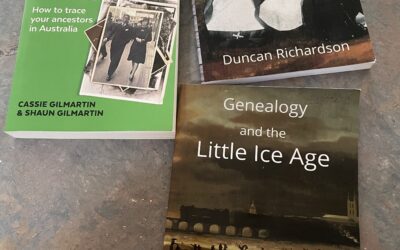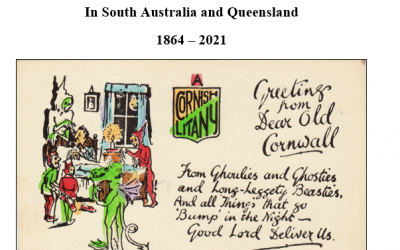This blog challenge is to stimulate my own genealogy blogging efforts in 2014 by focussing on a different kind of genealogical record each week. I wanted a challenge that reflected my own archival background as well as my own genealogy interests and there are probably lots of other records that I could have included. The challenge has an Australian focus but most of these records will be found just about anywhere in the genealogy world.
The 52 different types of genealogical records I finally decided on are listed in no particular order (each week will be a random surprise). Originally I planned to do this over 52 weeks but I now realise that I have to factor in travel and illness so it will continue a little bit over a year. Anyone is welcome to do all or part of this blogging challenge. Let me know if you are participating and I will put a link to your post under each week’s challenge.
So far I know of five bloggers who are taking up the challenge and I have put links to their individual entries at the end of each week’s blog if they have submitted something for that week. Thanks Judy Webster, Sharn White, Cassmob, Anne and Sharon for participating and encouraging me to keep up the blog challenge myself!
Also participating in this blog challenge:
Campaspe Library Week 9
Sharon Week 9
Anne Week 9
Links to Week 1 Military Medals Week 2 Internal Migration Week 3 Probates (wills and administrations) Week 4 Memorial Cards Week 5 Family Stories Week 6 Land Records Week 7 Local Histories Week 8 Diaries
Week 9 Inquest Records
An inquest is held when someone dies in an accident, or has not been seen by a doctor for some time or if they have died in an institution such as an asylum or prison. In some ways I am lucky as many of my ancestors died in accidents or in institutions and the inquest has given me more information on the family.
I touched on this in Week 4 when I did Memorial Cards – my example was Sydney Herbert White and there had been an inquest into his death. I will not repeat that here as there are lots of other examples that I can use.
John Henry Gunderson, aged 39 years, was found lying unconscious at the foot of the back steps of his house on the Thompson Estate in Brisbane on 23 May 1932. He was taken by ambulance to the Mater Hospital but he died before arriving there. The post mortem certificate in the inquest file gave cause of death as a cerebral haemorrhage and syncope (natural causes). Also in the file were witness statements from the local police constable William Charles Fuge, the widow Violet Maud Gunderson and a neighbour Austin Patrick Walsh. So even if you do not have an inquest into an ancestor, you may find they were a witness but unfortunately witnesses are not usually indexed by name.
I find the witness statements the most interesting and where you are most likely to find information not recorded elsewhere. The neighbour Austin Walsh in his statement said he was alerted to John’s collapse by another neighbour Mrs Flanders who first saw him lying there. When he went over he saw that John was unconscious and called the ambulance and it was he who went in the ambulance with John to the hospital. He recalled the doctor on arrival saying that ‘life was extinct’.
Violet Gunderson told the inquest that her husband was not a very strong man but he never complained about being ill and that it was probably five years since he had last seen a doctor. On that occasion John wanted to join the Foresters Lodge but the doctor told him he could not pass him as he had a leaky valve of the heart. On the morning of John’s collapse, Violet had left home early to do some errands and returned home just after her husband had been found. She saw him lying there and the ambulance arrived shortly after. Violet did not go with her husband as she had a young baby to look after. Austin Walsh returned from the hospital and told Violet that John had died just as they arrived at the hospital.
Violet also gave personal details such as John’s date and place of birth, his parents names including his mother’s maiden name and father’s occupation. Also details of their marriage and that there was only one child from the marriage, a daughter Iris Merle aged 5 months. He was a teetotaller, he was not a returned soldier, he was not in receipt of a pension, he had no property or money but did have two insurance policies. The first was with Metropolitan Life Assurance Co but Violet did not know for how much and the second with Mutual Life and Citizens for £10 5s.
Violet was left a young widow with a baby and very little monetary support. Not only did she have to deal with her grief at losing her husband so early but she would also have been left wondering how she would continue to support herself and child.
Most inquests are also reported in the newspaper and John’s death was reported in the Courier Mail. The information was basically what was included in the inquest file only in brief. This is where a search of Trove can be useful in finding information on accidental or sudden deaths in the family. Once the date and place of death is known it is easy to then go to the relevant State Archives and look for an inquest file or register.
As this example shows, the witnesses statements usually give an account of a person’s last moments as well as giving personal and biographical information that may not be found elsewhere. As I mentioned at the start, I have numerous inquest files in my family records. Some of these are on direct ancestors but I also look for inquests on collateral lines and their descendants as these may also give family background.
Most State Archives have online guides to inquest records and some may even have online indexes so these should be consulted in the first instance. Also Trove may be useful in determining a date and place of death or inquest but also follow up with the archival record as well. Why not look for some inquest records in your families, you may be surprised.





Thanks for tackling this topic – I’ve seen reference to a Gt Gt Uncle and Gt Gt Aunt of mine who were tragically mown down in a traffic accident in the 1930’s in Sydney – it’s on the list to investigate – you’ve encouraged me to reconsider that it is do-able
Thanks Kerrie Anne. I didn’t mention that some inquest files also have photos in them and they can be disturbing to look at. Also some State Archives only kept the registers and not the files which is where the witnesses statements are. You would need to check with State Records NSW.
I have just written about inquest records for the AtoZ challenge. I used an inquest from a death in an asylum for my example. Regards
Anne
http://ayfamilyhistory.blogspot.com.au/2014/04/i-is-for-inquests.html
Thanks Anne I have put a link on to this challenge as well. It is good to see how different blog challenges can interlink. Regards Shauna